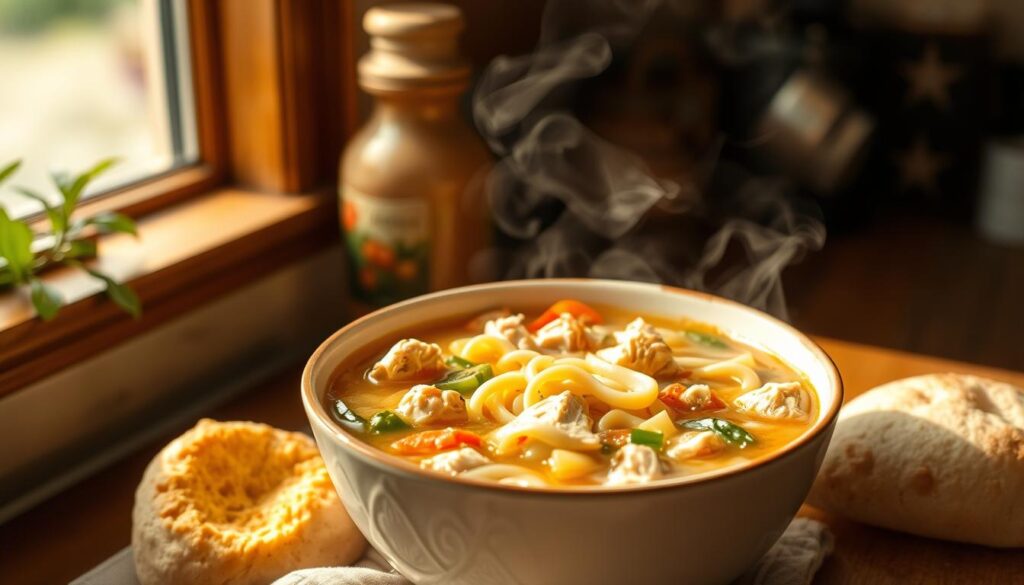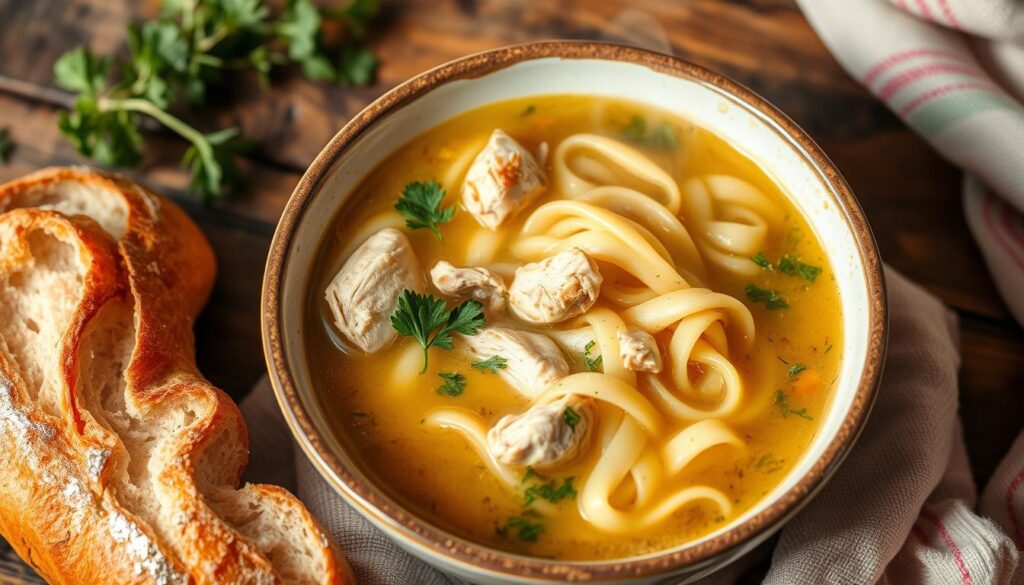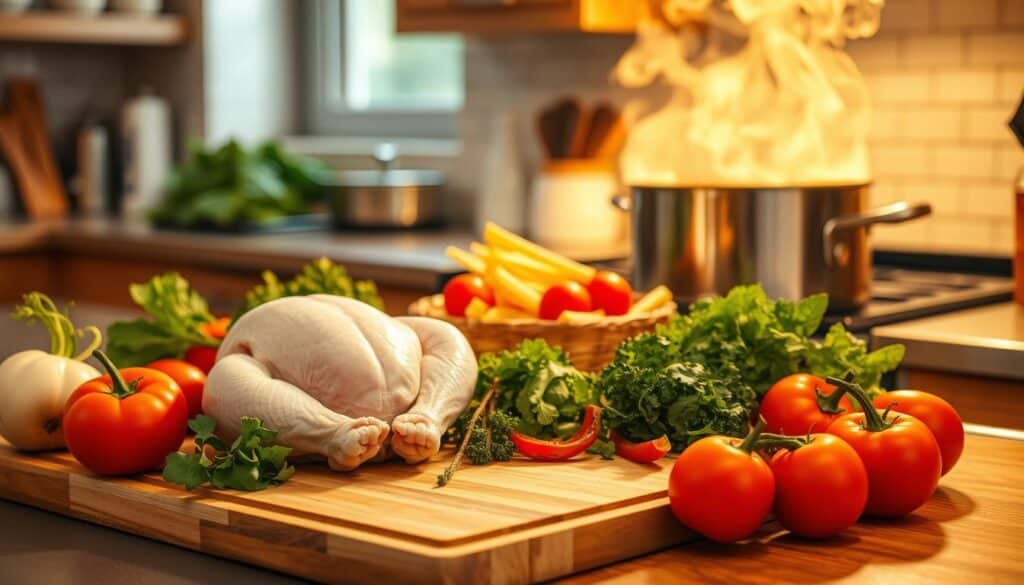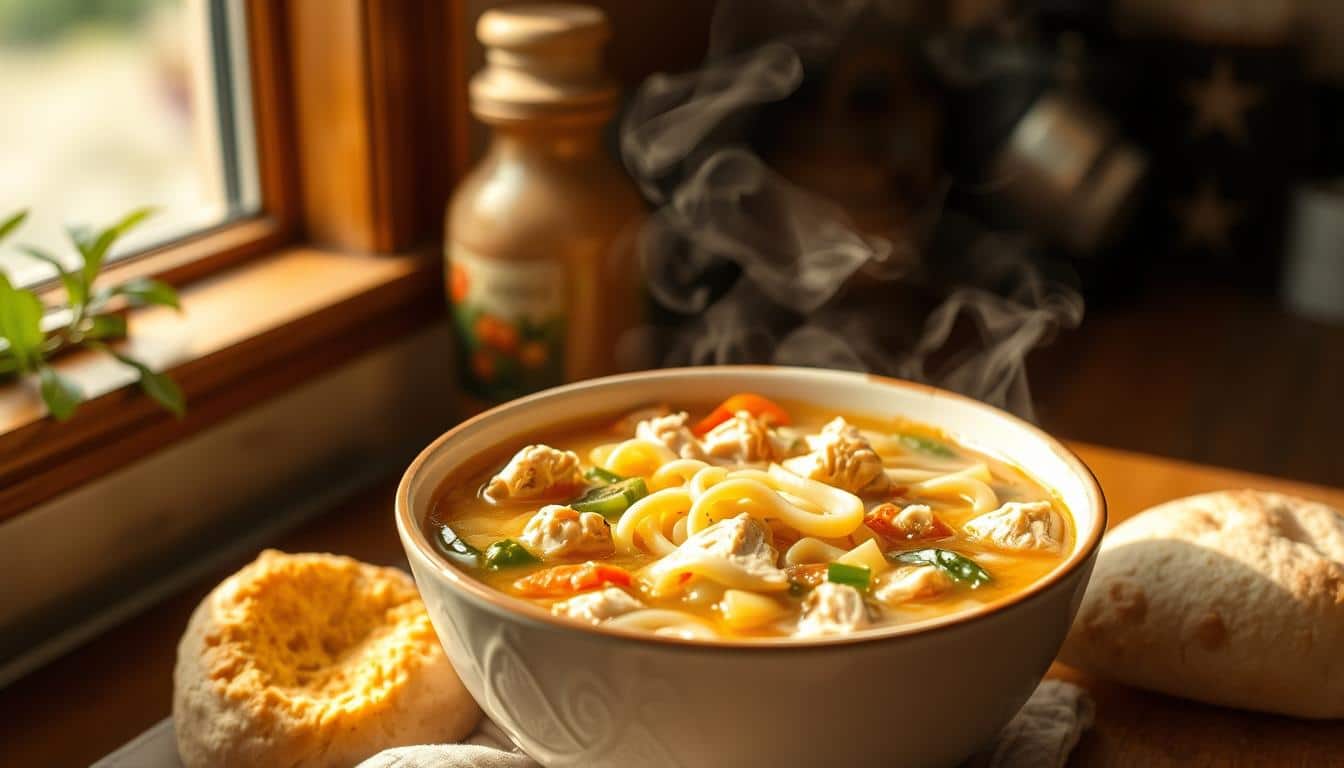There’s something magical about a warm bowl of soup on a chilly day. It’s not just about the taste but the comfort it brings. Nothing beats the rich flavors of a carefully crafted Homemade Chicken Noodle Soup that’s been perfected over time. Whether it’s a rainy afternoon or a busy weeknight, this dish has always been my go-to for warmth and satisfaction.
Thank you for reading this post, don't forget to subscribe!
What makes this recipe special is the blend of fresh ingredients and the love poured into every step. Every spoonful, from the savory broth to the tender vegetables, feels like a hug. I’ve learned that using quality ingredients, like rotisserie chicken and homemade stock, makes all the difference. It’s a dish that’s as nourishing as it is delicious.
Over the years, I’ve shared this recipe with friends and family, and it’s always been a hit. It’s more than just food—it’s a way to bring people together. You’re in the right place if you’re looking for a simple and satisfying dish. Let’s dive into the steps to create this timeless classic.
Key Takeaways
- Using rotisserie chicken adds depth of flavor and saves time.
- Homemade stock enhances the richness of the broth.
- Fresh vegetables like carrots and celery bring balance and nutrition.
- Egg noodles can be made quickly for an authentic touch.
- This recipe is perfect for meal prep or sharing with loved ones.
Introduction to My Comfort Food Journey
Soup has always been my go-to comfort food, especially on days when I need a little extra warmth. Growing up, my mom’s kitchen was filled with the aroma of simmering broth and fresh vegetables. It wasn’t just about filling our bellies—it was about creating memories. Those moments inspired my love for crafting recipes from scratch.
Why I Love Making Soup from Scratch
There’s something gratifying about starting with simple ingredients and turning them into something magical. When I make soup, I feel connected to my roots. It’s not just about the result—it’s about the process. Chopping carrots, sautéing onions, and simmering the pot on heat brings me peace.
Every step adds to the flavor and tells a story. This process soothes my soul whether it’s a rainy afternoon or a busy weeknight. Plus, it’s a chance to get creative. I can tweak the recipe to suit my mood or use what’s in my pantry.
The Magic of a Homemade Recipe
Handmade recipes have a unique charm. They’re customizable and full of personal flair. My mom’s broth recipe, for example, is a family treasure. It’s rich, savory, and made with love. Store-bought versions can’t compare.
Over the years, I’ve learned the importance of balancing flavor, texture, and nutrition. Fresh vegetables, quality chicken, and the right herbs make all the difference. It’s not just food—it’s comfort in a bowl.
Essential Ingredients and Their Role in Flavor
The secret to a genuinely comforting bowl lies in the quality of its ingredients. Each component plays a vital role in creating a nourishing and delicious dish. Every element contributes to the final flavor, from the savory broth to the fresh vegetables.
Choosing the Right Chicken and Broth
The chicken and broth are key to this dish’s base. I often use a rotisserie chicken for its rich flavor and convenience. It saves time and adds depth to the stock. Homemade chicken broth is my go-to because it’s richer and more nutritious than store-bought. Simmering the bones and vegetables for hours extracts every bit of flavor.
Veggies, Herbs, and Spices for Depth
Fresh vegetables like carrots, celery, and onions form the foundation of the soup. They add sweetness and texture, while garlic brings a savory kick. Herbs like thyme, parsley, and bay leaves enhance the aroma and complexity. A pinch of salt and pepper ties everything together, creating a balanced and unforgettable taste.
Check out these Campbell’s soup recipes for more ideas on elevating your meals. They’re perfect for quick, flavorful dishes that everyone will love.
Step-by-Step Guide for a Perfect Batch
Creating a comforting bowl of soup starts with mastering the basics. Whether you’re a seasoned cook or a beginner, following these steps ensures a flavorful and satisfying result. Let’s break it down into two key stages: preparing the stock and sautéing the vegetables.
Preparing Your Homemade Stock
Start by placing a large pot on medium-high heat. Add the bones and leftover meat from a rotisserie chicken to the pot. Pour in 7 cups of low-sodium chicken stock and bring it to a gentle simmer. This process extracts rich flavors and nutrients from the bones.
While the stock simmers, add a bay leaf, a sprig of thyme, and a handful of fresh parsley. Let it cook for about 45 minutes, stirring occasionally. The aroma will fill your kitchen, signaling that the base of your dish is ready.
Sautéing Vegetables for Maximum Flavor
Heat a tablespoon of olive oil or butter in a separate pan over medium heat. Add diced carrots, celery, and onion, stirring occasionally until they soften. This step enhances the vegetables’ natural sweetness and adds depth to the broth.
For an extra layer of flavor, mince a clove of garlic and toss it in during the last minute of cooking. Combining these ingredients creates a savory foundation that elevates the entire dish.
Once the vegetables are tender, transfer them to the pot with the stock. Season with salt and pepper to taste. Let everything simmer together for a few minutes to blend the flavors. This step ensures that every spoonful is packed with flavor and warmth.
Homemade Chicken Noodle Soup
Bringing together all the prepared components is the final step to creating a comforting dish. After preparing the broth and sautéing the vegetables, it’s time to combine everything in one pot. This is where the magic happens, and every spoonful becomes a burst of flavor.

Add the shredded rotisserie chicken to the pot with the simmering broth. Next, gently stir in the softened vegetables—carrots, celery, and onions. The combination of these fresh ingredients with the rich broth creates a base that’s both hearty and satisfying.
Now, it’s time to add the noodles. I prefer egg noodles for their tender texture, but you can choose your favorite type. Let them cook for about 5 minutes until they’re al dente. Overcooking can make them mushy, so keep an eye on the pot.
Before serving, taste the soup and adjust the seasoning. A pinch of salt and a dash of pepper can elevate the flavors. This is also a great time to add fresh herbs like parsley or thyme for an extra layer of aroma.
The result is a perfectly balanced bowl of soup—tender chicken, firm noodles, and hearty vegetables in every bite. It’s a dish that warms the soul and brings people together. Check out this detailed guide for more tips on perfecting your chicken noodle soup recipe.
Exploring Noodle Options and Their Impact
The choice of noodles can make or break your soup experience. From texture to flavor, the type you choose shapes the dish. Whether you prefer soft or firm, each option brings something unique.
Homemade Egg Noodles vs. Store-Bought Pasta
Homemade egg noodles are a labor of love. They’re tender and fresh and absorb the broth beautifully. I often make them in just minutes, and their texture elevates the entire dish. However, store-bought pasta offers convenience and variety.
Shapes like farfalle, elbow macaroni, and rotini each have their own charm. Farfalle holds up well in thicker broths, while rotini adds a fun twist. The key is to slightly undercook store-bought noodles to prevent sogginess upon reheating.
Adapting to Different Texture Preferences
Texture is a personal preference. Some enjoy soft, melt-in-your-mouth noodles, while others prefer a firmer bite. Experimenting with different types helps you find your perfect match. Try pairing your soup with creamy beef tips with egg noodles for a creamy twist.
Regardless of your choice, the broth and chicken remain the stars of the dish. The noodles are just the supporting cast, adding depth and heartiness to every spoonful.
| Noodle Type | Texture | Best For |
|---|---|---|
| Homemade Egg Noodles | Tender, fresh | Rich, hearty broths |
| Farfalle | Firm, holds shape | Thicker soups |
| Elbow Macaroni | Soft, chewy | Classic recipes |
| Rotini | Twisted, fun | Light broths |
Don’t be afraid to experiment. Share your feedback and find the balance that works for you. After all, the best recipe is the one that brings you comfort and joy.
Expert Tips and Tricks from My Kitchen
Over the years, I’ve discovered a few kitchen secrets that elevate every bite. These tips save time and enhance your dish’s flavor, making it a go-to recipe for any occasion. Let me share some of my favorite techniques to help you create a truly memorable meal.

Using Rotisserie Chicken for Extra Taste
One of my go-to shortcuts is using rotisserie chicken. It’s already perfectly cooked, saving prep time while adding a deep, savory flavor to the broth. Shred the meat and add it to your pot during the final stages of cooking. This method ensures the chicken remains tender and juicy, enhancing every spoonful.
Seasoning Secrets and Adjusting for Health
Seasoning is where the magic happens. I always add salt towards the end of cooking to avoid over-salting. A pinch of pepper and fresh herbs like parsley or thyme can elevate the dish without overpowering it. For a healthier twist, use low-sodium broth and reduce the amount of added salt. You can also skim off excess fat for a lighter, yet equally delicious, result.
Here are a few more tips to keep in mind:
- Simmer your broth on medium heat to avoid overcooking the chicken.
- Use a large pot to ensure even cooking and ample space for all ingredients.
- Experiment with spices like crushed red pepper for a subtle kick.
Check out these chicken soup tips for more detailed advice on perfecting your dish. They’re packed with insights to help you master the art of soup-making.
With these tricks, you’ll create a dish that’s not only flavorful but also tailored to your preferences. Happy cooking!
How to Store, Reheat, and Enjoy Later
Properly storing and reheating your dish ensures it stays fresh and flavorful for days. Whether you’re meal prepping or saving leftovers, these tips will help you enjoy every bite just as much as the first time.
Proper Cooling and Refrigeration Techniques
After cooking, let the dish cool slightly before transferring it to the fridge. I recommend using an airtight container to keep it fresh. Cooling it too quickly can affect the texture, so avoid placing hot food directly into the refrigerator.
For larger portions, divide the meal into smaller containers. This speeds up cooling and makes reheating easier. It can last in the fridge for up to 5 days. Always label containers with the date to keep track of freshness.
Freezing Guidelines for Long-Term Enjoyment
Freezing is a great way to extend the life of your meal. Use freezer-safe containers or resealable bags, leaving some space for expansion. Portioning it into single servings ensures you only thaw what you need.
When ready to enjoy, thaw it overnight in the fridge. Reheat gently on the stovetop over medium heat or in the microwave in 1-minute intervals. Adding a splash of broth or water can revive the flavors and prevent it from drying out.
| Storage Method | Duration | Tips |
|---|---|---|
| Refrigeration | 4-5 days | Use airtight containers, label with dates |
| Freezing | 2-3 months | Portion into single servings, leave space for expansion |
By following these steps, you can savor your meal days or even months later. Proper storage and reheating ensure every bowl tastes just as comforting as when it was first made.
Conclusion
Crafting a comforting meal from scratch brings joy and warmth to any day. From selecting fresh ingredients to simmering the perfect broth, every step adds to the process’s unique charm. The result is a dish that’s not only delicious but also deeply satisfying.
Making this recipe from scratch allows you to control the flavor and nutrition, ensuring every bite is as nourishing as it is tasty. It’s a simple yet heartwarming way to unite people, whether for a family dinner or a quiet evening alone.
I encourage you to try this recipe and make it your own. Experiment with different ingredients or spices to suit your taste. The beauty of cooking from scratch lies in its flexibility and creativity.
I’d love to hear your tips and variations! Share your experiences and join a community of home cooks who enjoy creating comforting meals. Thank you for letting me share this recipe with you, and stay tuned for more heartwarming dishes to come.
FAQ
What’s the best type of chicken to use for this recipe?
For convenience and flavor, I prefer using a rotisserie chicken or chicken breast. Thighs also work well if you want a richer taste.
Can I use store-bought broth instead of making my own stock?
Absolutely! Store-bought broth is a great time-saver. Just opt for low-sodium versions to control the salt level.
How do I make the soup healthier?
I reduce the sodium by using low-sodium broth and skipping adding extra salt. You can also add more veggies, like carrots and celery, for extra nutrients.
What’s the best way to store leftovers?
I let the soup cool completely, then store it in an airtight container in the fridge for up to 3 days. For longer storage, freeze it in portions.
Can I freeze the soup with the noodles in it?
I recommend freezing the soup without the noodles, as they can become mushy when reheated. Add fresh noodles when you’re ready to serve.
How do I reheat the soup without losing flavor?
I reheat it gently on the stovetop over medium heat, stirring occasionally. If it’s too thick, add a splash of broth or water.
What herbs and spices work best for this recipe?
I love using thyme, bay leaves, and parsley for a classic flavor. A pinch of black pepper adds a nice kick.
Can I use egg noodles or should I stick to regular pasta?
Egg noodles are my go-to for their soft texture, but you can use any pasta you like. Just adjust the cooking time accordingly.
How can I make the soup more flavorful?
I sauté the vegetables like onions, carrots, and celery before adding the broth. It really enhances the overall taste.
Can I make this soup in a slow cooker?
Yes! I add all the ingredients except the noodles to the slow cooker and cook on low for 6-8 hours. Add the noodles at the end.
There are no reviews yet. Be the first one to write one.

